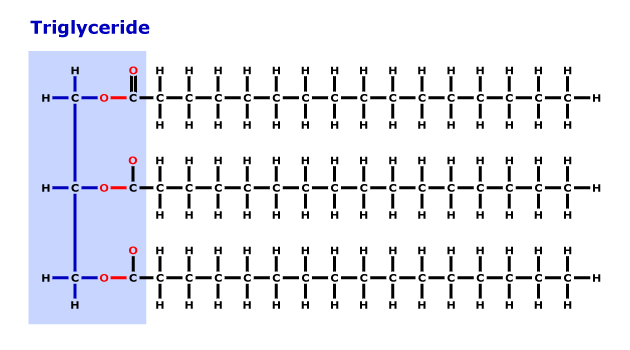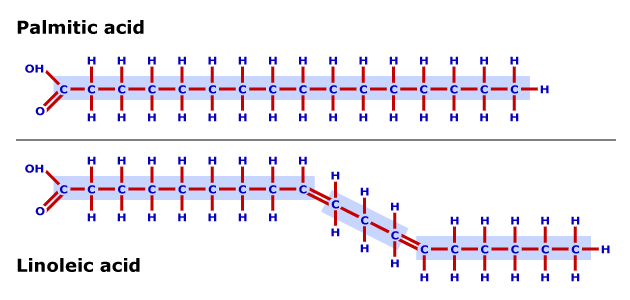Previous Page | Right click this page to print.
Lipids
The fourth of the six nutrients is lipids. Lipid determination is based on solubility. Lipids are organic compounds insoluble in water and soluble in organic solvents. Chemically, lipids include a number of compounds. In animal nutrition, the most common lipids are triacylglycerols. Triacylglycerols are commonly referred to as triglycerides. Figure 2.9 illustrates the general chemical structure of a triglyceride. Triglycerides are composed of three individual fatty acids (FA) attached to a glycerol backbone. Each fatty acid is attached via an ester bond. Fatty acids are described using the following notation: (C#:#). In the notation, the first # states the number of carbons in the fatty acid and the second # states the number of double bonds in the fatty acid. For example, a fatty acid with 18 carbons and 0 double bonds is stated as C18:0.

Commonly, three classification schemes are used to describe lipids or their components. The first scheme is based on the chemical structure of the fatty acid.
Fatty acids are classified as either saturated or unsaturated. Saturated
fatty acids are fatty acids in which each carbon atom in the chain is
saturated with hydrogen bonds. Figure 2.10 illustrates the structure of
a saturated fatty acid. 
Unsaturated fatty acids are fatty acids in which each carbon atom in the chain is not saturated with a hydrogen bond; rather a carbon forms a double bond with an adjacent carbon atom. Monounsaturated fatty acids are fatty acids with one double bond and polyunsaturated fatty acids are fatty acids with more than one double bond. Figure 2.11 illustrates the structure of an unsaturated fatty acid.
The second classification is based on physical characteristics. Lipids are classified as either fats or oils. At room temperature, fats are in a solid form. In contrast, at room temperature, oils are in a liquid form. Lipids are also classified based on origin. Lipids either originate from animals or plants. Generally, lipids from animal sources are also classified as a fat and contain saturated fatty acids. And generally, lipids from plant sources are classified as oil and contain unsaturated fatty acids.
Lipids are included in the diet for two primary reasons. The first reason is as an energy source. When metabolized by a mammal, lipids are the most energy dense nutrient. One gram of lipid will yield approximately 2.5 times the amount of energy as either one gram of carbohydrate or one gram of protein. The second reason is lipids are a source of essential fatty acids. Fatty acids are essential for a variety of structures and processes. For example, lipids are an essential component of plasma membranes and hormones and act as carriers for fat-soluble vitamins.
Similar to the concept of essential amino acids, there are dietary essential fatty acids. Essential fatty acids are fatty acids required in the diet because the animal cannot synthesize the fatty acid in an adequate amount to meet their requirement. For all mammals, the two dietary essential fatty acids are linoleic acid (C18:2) and linolenic acid (C18:3). A potential third essential fatty acid is arachadonic acid (C20:4). As arachadonic acid is synthesized from linoleic acid, arachadonic acid is only a dietary essential fatty acid if linoleic acid is not supplied in adequate amounts.
Lipids are digested and absorbed in the small intestine. In the small intestine, lipid digestion is initiated by bile. Bile is produced by the liver, stored in the gall bladder, and secreted into the small intestine. Bile salts emulsify the lipid. Emulsification of the lipid increases the exposed surface area of the lipid and facilitates enzymatic digestion of the lipid. Both pancreatic and intestinal lipases hydrolyze the triacylglycerol molecule, yielding primary free fatty acids and monoglycerides. The free fatty acids and monoglycerides are absorbed. Within the cells of the small intestine, these components are either immediately absorbed into the circulatory system or repackaged and absorbed into the lymph system. In either case, the compounds will be transported to tissues and metabolized.
Although the majority of lipid digestion and absorption is similar between monogastrics and ruminants, the rumen system introduces some points to consider. In the rumen, microbes can alter the structure of a lipid. One process is rumen microorganisms will add hydrogen to fatty acids, therefore converting unsaturated fatty acids to saturated fatty acids. Another process is rumen microorganisms will alter the position of double bonds, therefore producing fatty acids unique to ruminant products. Examples of these fatty acids include conjugated linoleic acids (CLA). In recent years, CLA has received attention because of CLA’s anticarcinogenic properties. Rumen microbes also have the ability to synthesize fatty acids. In addition to microbial processes, it is also important to note the amount of lipid fed to ruminants should be limited to 6% of the total diet. Feeding more than 6% lipid impairs efficiency of rumen fermentation. Although the exact mechanism is not defined, hypotheses include: 1) lipids coat the feed particles decreasing availability; and 2) lipids are toxic to the microorganisms reducing the ability of the population. As the natural feedstuffs fed to ruminants contain 2-3% lipids, an additional 3% may also be safely added to the diet. An additional option for high producing animals is to feed rumen-protected lipids. Rumen-protected lipids are chemically altered lipids that are rumen inert. These lipids pass through the rumen without being saturated and without influencing rumen fermentation. Rumen-protected fats may be added to the diet of high producing animals at the rate of 1-2% of the total diet.
Previous Page | Right click this page to print.